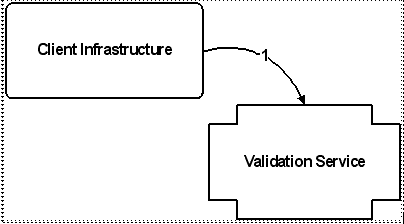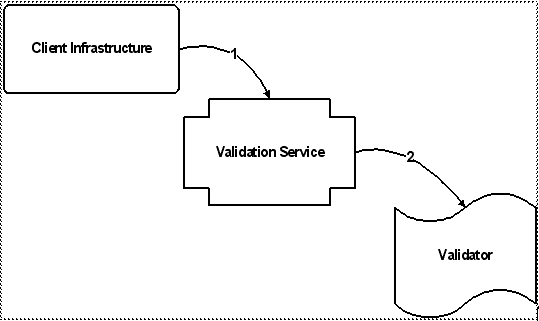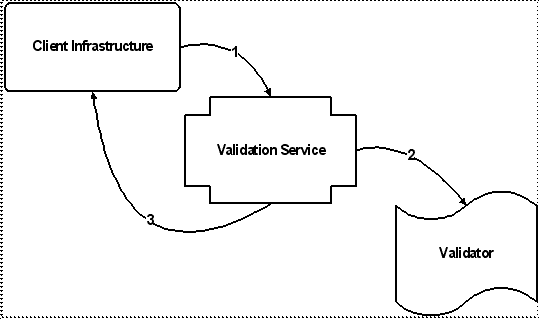Post-Select Validation Sequence
Conceptually, post-select validation occurs immediately after a user invokes an action in the UI. In reality, however, post-select validation actually takes place when the target page is being rendered. In other words, there is logic in begin.jspf (code that is included on every JSP page authored in the Windchill Client Architecture) that will call the validation service to determine whether or not the page should be rendered before actually rendering it.
Validators are the only accepted locations for post-select validation logic. Unlike pre-validation, there is no interaction with the solution groups, role-based UI service, or filters for post-select validation. Therefore, the sequence for post-select validation is much simpler than for pre-validation.
First, the client infrastructure calls the validation service, passing the action corresponding to the page being rendered (this action is represented by a validation key). Along with the action, the client infrastructure passes the context data in the form of a validation criteria instance.
Key |
1. The Client Infrastructure calls the validation service, passing an action (represented by a validation key) corresponding to the page being rendered, and the context data (represented by a validation criteria instance). |
After receiving a post-select validation request from the client infrastructure, the validation service checks to see if there is a validator associated with the specified action.
As is the case with pre-validation, a validator is associated with an action by creating an entry in a service.properties.xconf file that links the action id to the class name of the validator class for that action.
If there is not a validator registered for the action, the user is permitted to perform the action. Otherwise, if there is a validator associated with the action, the validation service calls that validator to get a validation status for the action.
Key |
1. The Client Infrastructure calls the validation service, passing an action (represented by a validation key) corresponding to the page being rendered, and the context data (represented by a validation criteria instance). 2. The validation service checks to see if there is a validator associated with the action. If so, it calls the validator to get the validation status (permitted or denied) for the action. |
After the validator returns its validation result, the validation service simply passes along the validation result returned by the validator to the client infrastructure. The client infrastructure will check to see whether that status is “permitted” or “denied”. If the status is “permitted”, the page or wizard is displayed. If the status is “denied”, the user is redirected to the previous page, and if the validator returned a message indicating why the action was denied, that message is displayed to the user.
Key |
1. The Client Infrastructure calls the validation service, passing an action (represented by a validation key) corresponding to the page being rendered, and the context data (represented by a validation criteria instance). 2. The validation service checks to see if there is a validator associated with the action. If so, it calls the validator to get the validation status (permitted or denied) for the action. 3. The validation service passes the validation status (wrapped in a validation result) from the validator to the client infrastructure, which either displays the target page/wizard, or brings the user back to the page where the action was invoked. |



